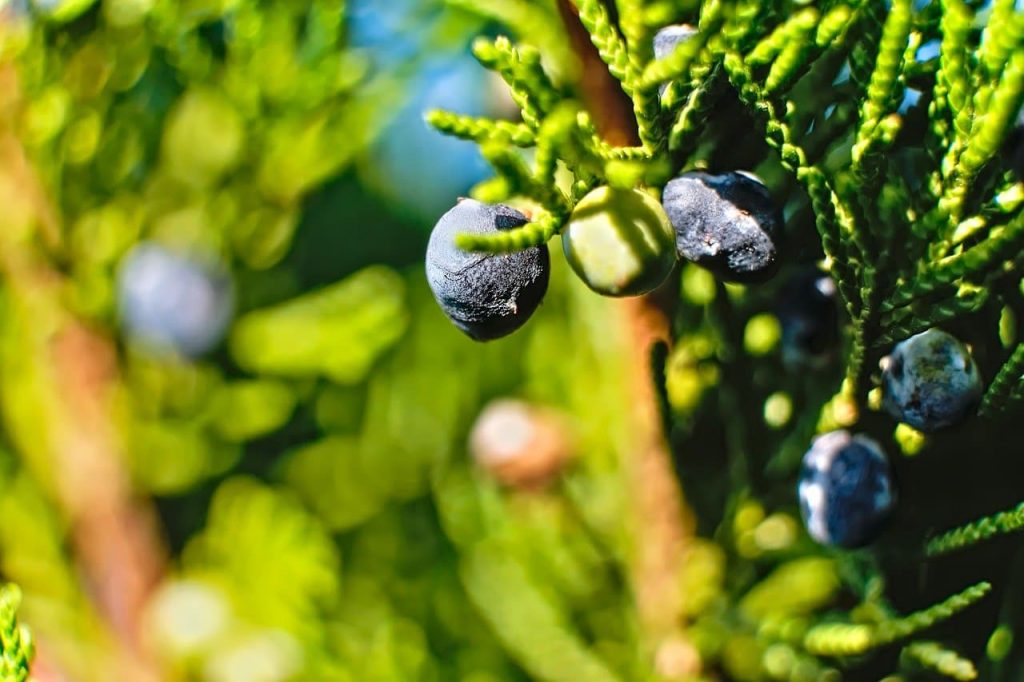The juniper berry is a spherical berry of the common juniper that develops over two years, changing color from bluish to black over time. The evergreen plant is also planted here as an ornamental plant, but its berry is also well-known: it is also used as a spice, fragrance and herb. It is also flavored with alcoholic beverages, but it was given a role in the kitchen mainly because of its pleasant smell.
It is a common ingredient in meat marinades and harmonizes well with rosemary and garlic. It’s also worth thinking about when making pickles and fish, especially if the food is grilled or smoked.
It has been used favorably since ancient times because of its strong fragrance, it was also used for embalming in Egypt, but it is also part of religious ceremonies, as it is believed to cleanse both body and soul. So it is a very important winter spice because it improves well-being and even warms cold hands and feet. Due to its antiseptic effect, it can be consumed as a tea for stomach and intestinal problems and is also suitable for the treatment of skin problems such as psoriasis.
By the middle of the 17th century, he had made several Dutch and Flemish distilleries flavored with juniper, cumin, and other spices, and sold them as medicine to cure chest problems, from coughs to heart problems. Finally, the Dutch are for the production of the generator, which is the most popular of the tonics. The process has been refined.
Appearance of juniper berries in beverages
Gin has become extremely popular III. During the reign of William, who came to power over England, Ireland and Scotland in 1689 and immediately carried out what some historians called ‘free gin for all’ or ‘free distillation for all’. Due to the high taxation of foreign drinks and breweries, people turned to home distillation, encouraged by The Corn Laws.
It was a series of corn tax breaks for those who make their own drinks. Thanks to these laws, a pint of gin can be easily sold for less than a pint of beer, and it’s the perfect ingredient for a bona fide gin frenzy. Eventually, the madness came from his hands, and people drank instead of working, especially in the poorer classes.
Eventually, England passed a law requiring gin distillers to buy a license, but that didn’t stop the bootleg booze from popping up. Nevertheless, beer only became cheaper than gin until the 1830s.
There are other known and interesting histories of this plant. Former juniper berries remain in the tomb of Tutankhamun in ancient Egypt. This is probably because they are thought to serve medicinal purposes long before they are considered culinary ingredients.
Juniper Berries is a diuretic often used throughout history and irritates the kidneys and results in more urine production. It has also been used to treat tapeworms, and it has been said that keeping berries at home helps prevent evil spirits. In the United States, juniper berries have often been used and are still used in jewelry making in indigenous American communities.
Growing juniper berries
Junipers, or shrubs, are found in the northern hemisphere and are native to the United Kingdom. They prefer poor soils and low-light areas, although they are fine in slightly sunnier areas. These areas are very well shaded. The berries of these plants appear green and then darken to about 2-3 mature, smooth-bodied purple-black. The berries will be about the size of a large pea and are waxy to the touch.
The juniper berries each appear at different times, so each tree or shrub is likely to have berries at different stages of growth. Trees are often short, but some can be up to 32 feet, depending on growing conditions. After picking the berries, they are dried on the shelves in direct sunlight.
Junipers should be stored in an airtight container, exposed to little light or heat, as light and heat degrade the quality of the juniper berries more quickly.
Cooking with juniper berries
Juniper berries are the most popular during the hunting season in the fall, as they are suitable for masking the aroma and giving an interesting aroma to game meat. This is the case all over the world, but in the United States, we see this in the history of Native American cultures in the Northwest region that use crushed juniper berries to taste wild buffalo.
In Europe, cured moose and beef are used in pickles or cattle, and in Germany, they are used to flavor cabbage.
In the United States, juniper berries are often found in pickles, brine, fillings, and sauces. Use with apples, beef, duck, goose, pork, salted beef, and pickles.
Juniper berries fit together: cumin, garlic, marjoram, pepper, rosemary, and thyme.
What does juniper berry taste like?
The aroma of juniper berries is bitter, the taste is clear, slightly citrusy, slightly pine and slightly sweet. Some people also have a slightly mild, pleasant burning sensation. Junipers have to wait until the berries are crushed, only to be used, as this releases their essential oils and enhances their taste. If it is ground too soon, it will quickly lose its flavor.
Last updated: September 24, 2023



Comments are closed.